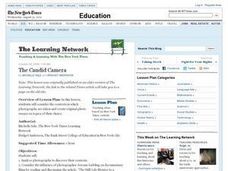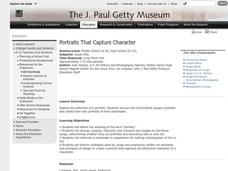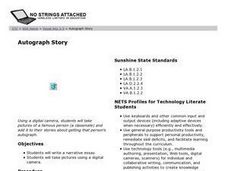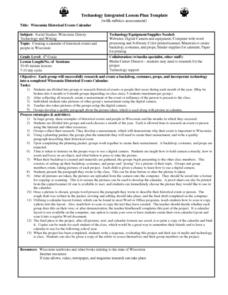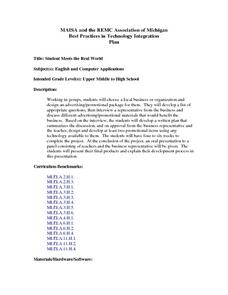Curated OER
Habitats
First graders investigate animal habitats. In this habitats instructional activity, 1st graders visit the woods to identify examples of food, water, and shelter that animals use to survive. Students complete a worksheet.
Curated OER
Digital Research: The Michigan of Today
Fourth graders explore present day life in Michigan with the past. They compare information on various aspects of Michigan. Students research rural life, city life, tourism, and agriculture. They create a PowerPoint presentation on their...
Curated OER
Using Photographs and Models for Drawings
Students make drawings of their classmates in photographs.
Curated OER
Natural Collaboration: Building With the Five Elements of Art
Young scholars assemble found natural objects into an artistic arrangement. They photograph their arrangement and Photoshop to enhance their artwork.
Curated OER
Crime Scene Documentation
Young scholars become forensic investigators. In this crime scene lesson, students go to the science lab which is the "scene of the crime." They collect evidence such as fingerprints, "blood" evidence, chromatography, footprints, and...
Curated OER
Digital Kids Club
Students create a slideshow on a chosen subject. They connect to the subject matter through images from the Internet, books, or pictures they have taken. Students convey the emotions the topic elicits and demonstrate understanding of the...
Curated OER
Torn Paper Collage Portrait
Students watch demonstrations on how to create a collage out of different materials. Using town paper, they create their self-portrait and view art by Andy Warhol and Roy Lichtenstein. To end the lesson, they discuss a career in fashion...
Curated OER
The Candid Camera
Students examine the influence of photographer Jerome Liebling on documentary films. They read and discuss an article, take photographs, and create an original photo essay and artist statement.
Curated OER
Food Advertising Tricks
Students recognize techniques used to make food look appealing on television and in advertising, and explore the separate elements that compose media messages and products.
Curated OER
Portraits That Capture Character
Students analyze two of Dorothea Lange's portraits and create their own portraits of classmates. In this portrait analysis lesson, students define portrait and discuss two images of Lange's. Students interview a classmate and use Lange's...
Curated OER
Promoting Reading Posters
Students create a series of large posters to encourage reading on the campus. In this reading posters lesson, students use a camera to take pictures of students reading in order to promote reading on their campus. Students use digital...
Curated OER
Make a Switch: Let There Be Light
Learners research a notable painter and use his or her work as inspiration to create a functional light switch plate. In this art instructional activity, students find an artist whose work is appealing to them to research and...
Curated OER
Power of Symbols in West African Art
High schoolers examine and analyze symbols used in the Asante community of Ghana and look at the history of power struggles in West Africa. They discover how to express meaning and power as they create their own symbols and short...
Curated OER
Diazo Prints and Technology
Fifth graders watch a demonstration and then they make photographic prints using Diazo paper and ammonia. They photograph the demo, compile the pictures, and add text to make a PowerPoint presentation of the original demonstration.
Curated OER
Autograph Story
Learners write narrative essays about getting a famous person's autograph (a classmate) and then combine their work with pictures to enhance the stories. This technique can be used with any writing project.
Curated OER
Cashton Community Quilters
Fourth graders create and construct a fabric quilt symbolizing the heritage of the Wisconsin community of Cashton. They research Wisconsin historical symbols and use math skills to calculate the number and sizes of the quilt squares. ...
Curated OER
Wisconsin Historical Events Calendar
Fourth graders create a calendar of historical events and people in Wisconsin. They select a month of the year and research events and people using the Internet and other resources. They collect their research and create a reencactment...
Curated OER
Sensational Seasonal Students
First graders analyze the seasons and cycles of the Earth. In groups, they create a seasons book on the computer using their own photographs and graphics. Using the photographs, they note the differences in clothing and activities. They...
Curated OER
Black Hawk and the Black Hawk Trail
Fourth graders investigate the American Indian tribe of Black Hawk and its trail. They use computers and a variety of technology resources to find information and put together a multimedia presentation. The end result is a storyboard...
Curated OER
Windows of Wisconsin (History)
Fourth graders research the history of Wisconsin. They explore Wisconsin's culture, sovereignty and environment. Using multiple computer technology resources (computer, scanner, camera, internet), 4th graders develop a book on the...
Curated OER
Student Meets the Real World
Young scholars interview a local business person in order to design an advertising or promotional for their business. They summarize the meeting and use the information to design two promotional items using available technology. They...
Curated OER
Animated Cartoons
Students draw ten frames for a cartoon and then use iMovie to create an animated movie in this technology-based art lesson. Transitions and audio tracks can be added to enhance final products.
Curated OER
My Neighborhood: A Webquest
Learners engage in a Webquest to discover their school and community. They interview staff members of the school, create maps and take digital photographs of the school. As they write about their school, they use Microsoft Word to...
Curated OER
Math/Technology: Measuring Objects
Third graders create Powerpoint templates of pictures they have taken. Using both standard and metrric measurement units, they describe what units of measurement they would use for each object. In the computer lab, they work in pairs to...







